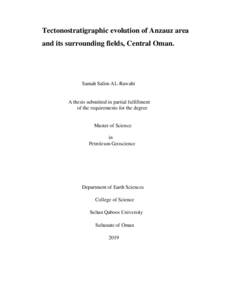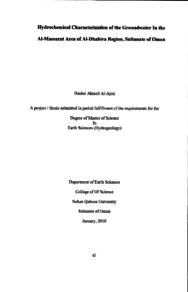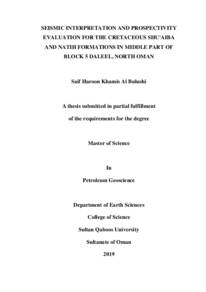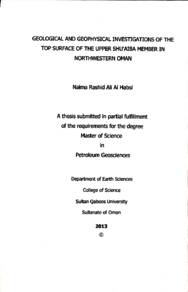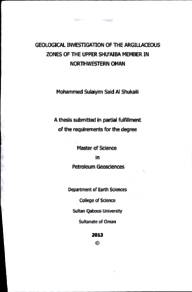Document
.Tectonostratigraphic evolution of Anzauz area and its surrounding fields, Central Oman
Publisher
Sultan Qaboos University
Gregorian
2019
Language
English
Subject
English abstract
Anzauz field is one of the major oil field in central Oman area. It is dissected by a graben fault system which developed over a release bend of a strike-slip fault system that probably was enlarged by the movement of the underlying salt. This graben separates the NE and SW accumulations. Previously, poor seismic imaging in central Oman obstructed further exploration of this prominent and undiscovered area. In 2017, new 3D seismic data was acquired across the Central Oman area, resulting in further studies in tectonostratigraphic evolution of the area. This study, tectonostratigraphic evolution of Anzauz field and it is surrounding area in Central Oman, mainly focused on the tectonic/structure and stratigraphic evolution of Anzauz field from Neoproterozoic to Cenozoic times utilizing the new 3D seismic data, well data, satellite images and geological maps.
The Anzauz field is interpreted to be formed above a deep-seated older (Neoproterozoic Early Cambrian) fault system, strike in NW-SE direction. Older tectonic events seem to play key roles in the evolution of the Pre-Cambrian Nafun Group, which in turn influenced the subsequent deposition of the Ara Group. Mapping of the key horizons in the study area showed that the long-lived basin highs controlled greatly the position of the basin fill, including the salt deposition and thinning and thickening of the overlying stratigraphy. For example, Nimr Group (Cambrian) is thicker to the west of Anzauz high and is overlained by the Angudan unconformity. The studied area also highlighted some key challenges in the understanding of pre-Salt rocks and Haima Supergroup, including the presence of huge and clear reverse faults above Nafun Group, the growth packages within Miqrat Formation and the thickness variation within Haima formations especially above Anzauz and Suwaihat highs.
Salt movement might be the reason of this thickness variation but tectonics can not be ruled-out. During post Miqrat deposition, an extensional stress was dominating, forming pull- apart basin. Locally, Safiq Group was truncated by base Ghudun unconformity which indicates the activity of Anzauz during Ordovician time. The lack of seismic contrasts between the clastic reflectors and the absence of clear biostratigraphic markers within Haima and Nimr packages remain the main challenges During post-Haima deposition, the basin fill showed a quiescent stage characteristic (no clear thickness variations), which was later truncated by base Jurassic regional unconformity affecting the Triassic and Jurassic sections. Finally, the Alpine-1 and -2 tectonic events have affected the Anzauz area, resulting in re-activation of some of the pre-existing faults.
Overall, the Anzauz structure is interpreted as a salt-cored structure formed above a salt body and has been subjected to many phases of re-activations throughout geological times. Knowing the stages of deformations can help in exploring the full Prospectivity of Anzauz structure.
Key words: tectonostratigraphic evolution, tectonic events, pull-apart basin, highs, Anzauz high, Central Oman.
Member of
Resource URL
Arabic abstract
يعد حقل عنزوز أحد الحقول الرئيسية في وسط عمان في منطقة إنتاج بنجة ريماء التي تم تطويره في نظام انزلاق و هو على الأرجح بسبب حركة الملح في المنطقة في السابق ، أعاق التصوير الزلزالي الضعيف في وسط غمان الاستكشافات الإضافية للمناطق الواعدة وغير المكانة في عام ۲۰۱۷ ، كانت البيانات الزلزالية" الجديدة تقنية الأبعاد التي تم الحصول عليها متاحة لوسط عمان، السبب الذي ساعد في إطلق المزيد من الدراسات لفهم التطور التركيبي الطبقي عبر الأزمان المنطقة يركز هذا البحث "التطور التركيب الطبقي لحقل نزوز والمناطق المحيطة به في وسط عمان" بشكل أساسي على تطوير حقل عنزوز من العصر نیوبرونروزويك إلى حلبة الحياة الحديثة من خلال استخدام البيانات الزلزالية نتية الأبعاد ، وبيانات البئر، وصور القمر الصناعي والخريطة الجيولوجية مساعد التفسير الزلزالي لأحداث الرئيسية في المنطقة المدرسة على فهم التكوينات وتباين السماكة بين الطبقات مما ساعد في تكوين أنموذج للتطور التركيبي الحقيقي للمنطقة فسر حلل عزوز على أنه تكون في نظام صدع عميق الجذور الذي يتجه شمال غربي- جنوب شرقي ولعبت التكونية القديمة دور كبيرا في ترسب مجموع نفون والتي أثرت على ترسب مجموعة أرا, رسم خرائط الأفاق المهمة في المنطقة المدروسة أوضح أن المرتفعات الشاهقة تؤثر وبشكل كبير على مكان ترسب الطبقات بما فيها ثقير حركة الملح وغير سماكة الطبقات. على سبيل المثال، مجموعة تمر تكون أكلف غرب منطقة عنزوز كذلك مجموعة هيما، تتغير سماكة طبقائها لتكون أقل سمكا في منطقة عفزوز وأكثر سماكة بعيدا إلى الغرب من منطقة علزون، عزز حدوث هذا التغير في السماكة هو حركة الملح أو تعرض المنطقة إلى رفع بسبب تنشط بعض الصدع القديمة عند ترسب مجموعة هيما. وتشير البيانات الزلزالية إلى أن بعض رواسب مجموعة هيما تعرضت للتأكل و التعرية بسبب تلامس غیر متطايق بين رواسب المجموعة نتيجة للرفع التي تعرضت له المنطقة الجدير بالذكر أن عدم وجود اختلاف في العواكس الزلزالية بين الطبقات التفكيكية و غياب الأحافير كضابط للمقارنة كان عارضا لتوقع الوقت المحدد لحدوث هذا التغير تبت هذه الأحدات، سماكة متساوية من الطبقات في العصر الكربوني مما يشير إلى سكون المنطقة آنذاك في العصر الجوراسي، تآكلت بعض من الطبقات مثل جلح، سدير، و أعلى طبقة خف بفعل القاعدة الغير المتطابقة في العصر الجوراسي مما يدل على نشاط المنطقة في ذلك الوقت في العصر الطباشيري تعرضت المنطقة إلى حدث مهم في عمان وهو الحدث البيني ۱- والذي احتوى على صدع طبيعية ممتدة باتجاه الشمال الغربي إلى الشمال الشرقي أما في العصر الجوراسي، تنشطت بعض من الصدع القديمة بفعل قوة الضغط وتحولت الصدع الممتدة طبيعية. إلى صنع مضغوطة . عكسية.
بشكل عام، تكون حفل عنزوز على وسادة من الملح ونتيجة لحركة الانزلاق التي ساعدت على تباعد المنطقة بواسطة صدع في العصر الطباشيري وتشير خرائط المظهر إلى أن هذا الصدع تنشط في عصور مختلفة الأزمان.
بشكل عام، تكون حفل عنزوز على وسادة من الملح ونتيجة لحركة الانزلاق التي ساعدت على تباعد المنطقة بواسطة صدع في العصر الطباشيري وتشير خرائط المظهر إلى أن هذا الصدع تنشط في عصور مختلفة الأزمان.
Category
Theses and Dissertations

